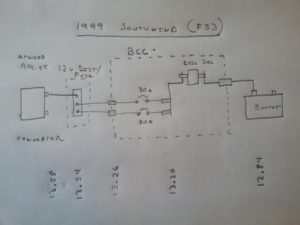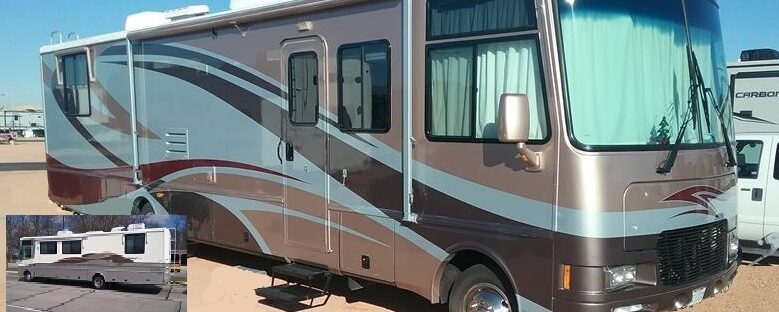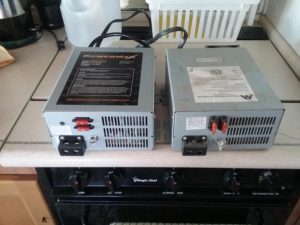NOTE – I’ve since did these upgrades to my 12 volt system READ HERE
Last spring we installed a residential refrigerator and a 1200 watt PSW (Pure Sine Wave) inverter to support it. This configuration works great for traveling, the inverter supplies 110 volts to the refrigerator and other circuits.
During our winter pilgrimage to Arizona, we spent 4 days out in the desert with no hookups. We discovered when boondocking, the existing battery storage and / or charging was not adequate. The first night out, the inverter was able to keep the frig running all night (12 hours). I suspect this is because the batteries were fully charged from the chassis while we were traveling. However, on nights two and three, the inverter went into alarm after about 6 hours. I made a modification to the wiring, and on night 4, it was better, but still went into alarm after about 9 hours.
This is what I discovered during several days of testing:
1) On generator or shore power, the OEM converter / battery charger doesn’t adequately charge the coach batteries. The converter is only capable of putting out 13.6 volts, but this doesn’t take into consideration the wiring loses between the converter and the battery.
2) The OEM battery configuration may not have adequate capacity to run residential frig for more than about 7-8 hours. We really need 12 hours.
3) The OEM factory converter, Atwood APC-55, doesn’t output a high enough voltage to do a fast charge.
4) Another side issue is the voltage from the converter isn’t high enough to trigger the BCC to also charge the chassis batteries. The BCC needs to see at least 13.2 volts before it connects the chassis battery to the coach battery.
5) I have two NAPA 24DCM batteries. I need to upgrade these to two 6 volt golf cart batteries.
6) The frig seemed like it had a hard start. I’ll install a hard start kit in it to see if this helps. Also, i’ll wire in two small circulation fans for the condenser that run when the compressor is running.
FACTORY WIRING
 I sketched out a diagram as to how the factory wiring supplied 12 volts. I then took voltage measurements to see what was going on in the system while charging from the converter. I discovered that I was losing almost 3/4 of a volt between the converter and the battery. I was seeing 13.6 volts at the converter, but only 12.8 volts at the battery. This is not acceptable to charge the battery. I could probably lower this by cleaning all connections and the contacts inside the isolation relay.
I sketched out a diagram as to how the factory wiring supplied 12 volts. I then took voltage measurements to see what was going on in the system while charging from the converter. I discovered that I was losing almost 3/4 of a volt between the converter and the battery. I was seeing 13.6 volts at the converter, but only 12.8 volts at the battery. This is not acceptable to charge the battery. I could probably lower this by cleaning all connections and the contacts inside the isolation relay.
TEMPORARY MODIFICATION.
To get the batteries to charge faster and higher voltage, I disconnected the wire from the convert to the distribution box, and ran a temporary wire connected directly between the converter and the battery. The only wire I had was a four conductor #14, so I tied all 4 conductors together for this temporary test run). This helped as it rose the voltage at the battery to 13.2 – 13.3 volts.
UPGRADED CONVERTER
I installed a 4 stage Converter PowerMax PM4-55 converter (left) to replace the original single stage Atwood APC-55 (right). This unit is identical physical size to the original unit. .
The advantage of the 4 stage converter is it automatically adjusts the output voltage to bring batteries up to full charge in a short amount of time. It starts charging at 14.7 volts, then as the battery is starting to reach full charge, it reduces the voltage to 13.8 volts. When the batteries are fully charged, it goes into a trickle / maintained mode with the voltage at 13.2 volts. This prevents the batteries from being boiled to death.


Putting out 14+volts to charge your batteries did your BCC board handled the change without any problems ?
No problems. the Alternator will also put out a high voltage initially when charging batteries.
How did you get access to it? I think my converter is what’s is making a loud but intermittent Geiger counter noise. But it looks to me like I need to pull the fridge to get at it. 99 Southwind 32’
My converter was located behind the 120 volt circuit breaker box.
Geiger counter clicking noise. Are you sure it isn’t your heat / A/C control module? Are you having problems with furnace or A/C units.
Well, the furnace and AC both work fine testing them for short periods. Where is that control module you speak of? It sounds like it coming from the transfer/relay delay it the converter. I’m going to use a auto transmission funnel as a heating device to try to pinpoint it – but it seems to have stopped making noise at the moment.
I have a 2000 Southwind 32V and the converter is different — INTELI POWER 9100 Model PD9155. Reading the manual, I found there is an optional TCMS device available for purchase. PD9105 TCMS Charge Wizard https://www.progressivedyn.com/rv/charge-wizard/pd9105-tcms-charge-wizard/
Apparently plugging this accessory into the TCMS port on the converter allows it do automatic mode changes.
BOOST MODE (14.4V) — Constantly monitors battery for voltage drop and quickly recharges battery or boosts power when needed.
STORAGE MODE (13.2V) — Ensures battery remains charged and reduces water boil-off during storage or long periods of inactivity.
NORMAL MODE (13.6V) — Continually monitors power usage, provides good charging capability and reduces water consumption.
Buying this $32 accessory on Amazon https://www.amazon.com/Progressive-Dynamics-PD9105V-Charge-Wizard/dp/B002OR41UM will save me the hassle of replacing the converter. Sweet!
do the chassis batteries get charged when plugged into shore power on a 1999 Southwind 32v
Yes. They need to be connected with the CONNECT / DISCONNECT switches. The Battery Control Center (BCC) will energize the isolation solenoid anytime the chassis or coach batteries are above 13.2 volts. Whne plugged into shore power, your converter will charge your coach battery at about 13.6 volts, so the isolation solenoid should energize and then also charge your chassis battery. (if its connected)
Where is the converter located on my 2004 Southwind 32vs ?
THANK YOU!
I’d say start looking behind your 110 volt circuit breaker panel.
why did you go with the 55 amp model…..they make bigger ones up to 100amp…for only 30$ more…..and the good thing is it says lithium compatible …so in the future I might want to switch to lithium when I put in solar….so is it ok to just buy the 100 amp largest one now….
55 amps is more than enough to supply my needs, especially when I upgraded the systems and lighting to lower power consumption. I also never envisioned the need (or cost) to go lithium.